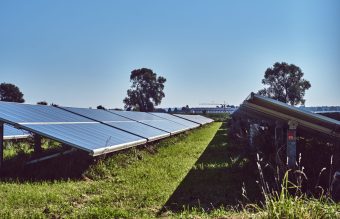
In early February, the MT-KOMEX Company started the construction of a photovoltaic power plant in Sisak-Moslavina County in Croatia. For the first time, the company is engaged in EU territory, thus continuing to expand its operations and gain more experience beyond Serbia’s borders.
The project is implemented in the city of Novska. MT-KOMEX is building a rooftop solar power plant with a total power of 280 kW AC and 340,625 kWp, for Thermo Stone d.o.o. Novska.
The plan is for the construction to be completed by the end of the current month or by the beginning of March at the latest.
In terms of equipment, the roof panels will be positioned in the southwest and northeast direction, with a slope that closely follows the roof’s slope. The company opted for Luxor Solar 545 Wp as the panel manufacturer and is using inverters from Fronius and a TR sheet structure for pitched roofs made by K2 Systems.
The electricity produced by this solar power plant will be used exclusively for local needs and will not be forwarded to the national power grid.
Considering that this is the first time that MT-KOMEX is working in the EU, it is interesting to note what differences and challenges they faced, although they are not drastically different to the usual working conditions that the company is accustomed to.
The works are carried out based on the Electric Power Installations Main Project, as well as the obtained Electric Power Permit (EPP), provided by the Croatian Electric Power Company (HEP). The company has to strictly adhere to the requirements and conditions stated in the EPP. The project also implies conducting certain studies, one of which is the Power Grid Impact Study.
More:
- THE PIONEER PROJECT OF THE MT-KOMEX COMPANY IN BIH – REŠETNICA
- MT-KOMEX AND FRONIUS ARE PARTNERS FOR THE FUTURE
- THE MT-KOMEX COMPANY EXPANDED BUSINESS IN BIH
The procedure for building a power plant is very similar to that in Serbia. To begin with, HEP very much resembles the Serbian power provider, EPS, and it has similar design and connection requirements (the so-called UPP), with a slight difference in the aforementioned studies that need to be drafted.
Essentially, both documents – EPP and UPP – are necessary when it comes to planning, designing and implementing infrastructure projects, as well as for issuing certain permits such as connecting the facility to the power grid. The goals of the two documents’ goals coincide, while the biggest difference actually lies in the terminology.
When simpler projects are implemented without a building permit, the project participants need to adhere to the relevant Rulebook, based on which supervision is not required, nor is reporting the execution work or keeping a construction site diary, which is very similar to the relevant rules in Serbia. As for the project which MT-KOMEX is currently implementing, the engineers in charge of this task have registered the works and keep a construction site diary according to their standards, given that in Croatia, the diary is kept exclusively through the eGrađanin website, which requires inputting a building permit number, which is another difference. One of the key challenges is actually exporting the required equipment, for which export customs clearance from Serbia and import customs clearance for Croatia must be carried out.
All in all, MT-KOMEX has added another town, this time in Croatia, to its reference list, in which it will produce green kilowatts and which will enhance the work experience of the company’s engineers.
Energy portal





